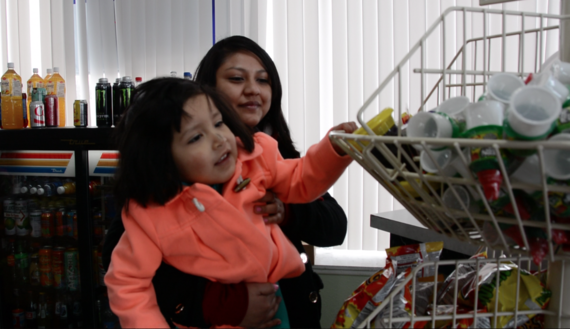PERRY, Iowa - There's a song that's written about the people of Iowa and the lyrics go like this; "We can stand touchin' noses for a week at a time and never see eye to eye." Despite their differences, this small Iowa town thrives in its unity.
You can find this city hard against the North Raccoon River. The 2010 census showed Perry's population stood at 7,702. But here's a fun fact about the town - it's approximately 35 percent Hispanic.

Customers go to Oasis to fill up on authentic Hispanic treats. Oasis is one of the many Latino businesses in Perry. Savannah Hurst/Huffington Post
"In the 80's, it started dying around here when the gas shortage came along and we lost the railroad. We were a little over 9,000 at that time and now we are down to 7,500," said Ruthann Eiteman, employee at Firehouse Ice Cream.
Eiteman has lived in Perry since 1965 and has spent the last three years helping her sons with their ice cream parlor in town. She remembers 2nd Street as a booming hubbub in the 60's. "I was a teenager then... but it's part of life... things change," she said.
In the late 80s, unions were busted in meat packing plants across the Midwest. Pertry's plant was on the verge of shutting down, meat packing plant in Perry was in danger of shutting down, according to the town's chamber of commerce.
"If the meat packing plant would have closed in the 80s, then the town would have diminished in size and capacity," said Jon Wolseth, an Iowa State University Community Development Specialist who specializes in Latino community development.
This opened the door for non-union workers, which in turn resulted in a wave of Latinos. Wolseth said the town saw the most immigration in 1992 and 1993.
According to the 1990 census, only 47 Hispanics lived in Perry at the time and the town's total population stood at 6,652.
"We have a lot of people that are accepting of everyone as they come in now and not worried about where anyone came from," Eiteman said.
Every year the town hosts a Hispanic festival Viva Perry! The event is an opportunity for Anglos to learn about Latino culture.
Laura Espinoza, another employee at Firehouse Ice Cream, moved from Mexico to the U.S. in 1993 and has been living in Perry since 1996.
"It was quite a shock for a child...we didn't know English so we couldn't communicate with our teachers or even ask to go to the bathroom," Espinoza said.
Since then, the little town has strived to come together, mixing cultures and new Latino-owned businesses have helped to rebuild the town's once failing economy.
The schools now teach Spanish as early as pre-school and over half of schools in Perry are Hispanic according to the chamber of commerce.
"When the meat packing plant threatened to close, the whole community rallied to keep it alive," Bob Wilson, Executive Director of Perry Chamber of Commerce, said.
Edith Barco, owner of El Buen Gusto Pupuseria, moved to Perry 20 years ago to start her business. "I'm from here, here is where my people are," she said. Barco said she chose Perry specifically because she prefers a rural market.
Edith used to work for the meat packing plant but had larger goals, which were to start her own, family-run El Salvadorian restaurant.
Hispanic businesses including Casa de Oro, Buen Gusto Pupuseria and El Rey Meat Market have played a vital role in the restoration of Perry's economy.
"You will always have the people that are going to say, 'go back to your country' but the thing is, this is my country now," Espinoza said.
Pam Ortega contributing reporter